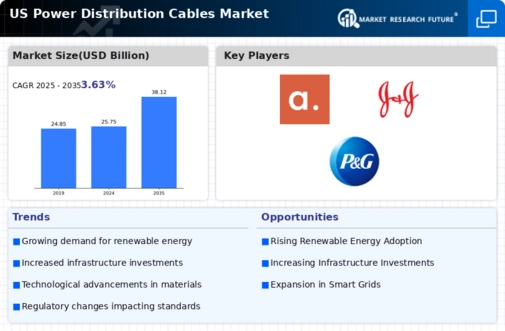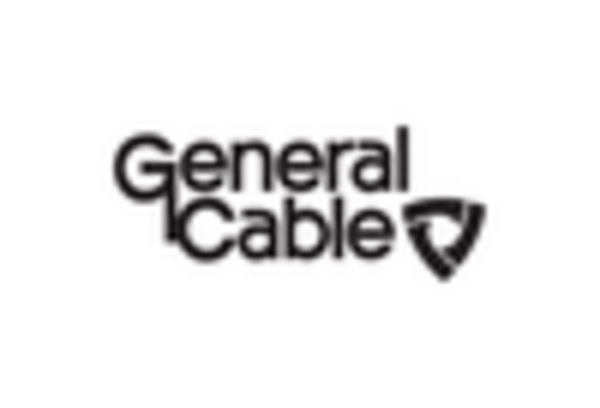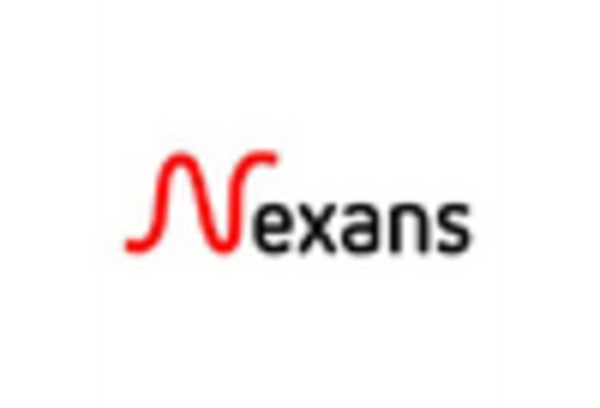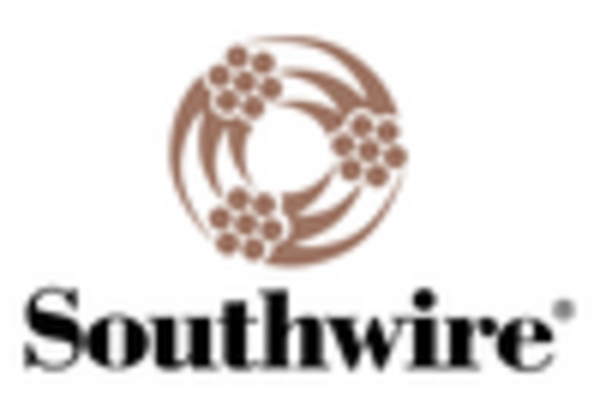Increased Energy Demand
The rising energy demand in the US is a critical driver for the power distribution-cables market. As the population grows and urban areas expand, the need for reliable electricity supply becomes paramount. Projections suggest that electricity consumption in the US could increase by approximately 1.5% annually over the next few years. This surge in demand necessitates the expansion and modernization of existing power distribution networks, which in turn drives the need for high-performance cables. Additionally, the increasing adoption of electric vehicles (EVs) and smart technologies further contributes to the heightened energy requirements. Consequently, utilities are compelled to invest in new power distribution infrastructure, thereby creating a favorable environment for the power distribution-cables market. The interplay between energy demand and infrastructure development is likely to shape the market dynamics significantly.
Regulatory Framework Enhancements
The evolving regulatory framework in the US is a significant driver for the power distribution-cables market. Regulatory bodies are increasingly focusing on enhancing safety standards and promoting the use of environmentally friendly materials in cable production. Recent legislative measures aim to reduce carbon emissions and improve energy efficiency, which directly impacts the specifications for power distribution cables. Compliance with these regulations often necessitates the adoption of advanced cable technologies, thereby creating opportunities for manufacturers. Additionally, the push for greater grid resilience and reliability has led to stricter regulations regarding the installation and maintenance of power distribution systems. As utilities and contractors adapt to these regulatory changes, the demand for compliant and high-quality power distribution cables is expected to rise, thereby influencing market dynamics.
Infrastructure Development Initiatives
The ongoing infrastructure development initiatives in the US are likely to bolster the power distribution-cables market. With the government allocating substantial funds for upgrading and expanding the electrical grid, the demand for high-quality power distribution cables is expected to rise. Recent reports indicate that the US government plans to invest approximately $1 trillion in infrastructure projects over the next decade, which includes enhancements to power distribution systems. This investment is anticipated to create a robust market environment, as utilities and contractors seek reliable and efficient cable solutions to meet the growing energy demands. Furthermore, the shift towards renewable energy sources necessitates the installation of new distribution networks, further driving the need for advanced power distribution cables. As a result, the infrastructure development initiatives are poised to significantly impact the power distribution-cables market.
Investment in Renewable Energy Projects
The increasing investment in renewable energy projects is a pivotal driver for the power distribution-cables market. As the US transitions towards cleaner energy sources, there is a growing need for robust power distribution infrastructure to support solar, wind, and other renewable energy initiatives. Reports indicate that investments in renewable energy could reach $500 billion by 2030, necessitating the installation of new distribution networks and upgrades to existing systems. This shift not only enhances energy security but also drives the demand for specialized cables designed to handle the unique requirements of renewable energy sources. Consequently, the power distribution-cables market is likely to experience substantial growth as stakeholders seek to capitalize on the opportunities presented by the renewable energy sector.
Technological Innovations in Cable Manufacturing
Technological innovations in cable manufacturing are transforming the power distribution-cables market. Advances in materials science and engineering have led to the development of cables that are not only more efficient but also more durable and environmentally friendly. For instance, the introduction of cross-linked polyethylene (XLPE) cables has enhanced performance characteristics, making them suitable for high-voltage applications. Furthermore, the integration of smart technologies into cable systems allows for real-time monitoring and management of electrical networks, improving reliability and reducing maintenance costs. As manufacturers continue to invest in research and development, the power distribution-cables market is likely to benefit from these innovations, which could lead to increased adoption of advanced cable solutions across various sectors. The emphasis on efficiency and sustainability in cable manufacturing is expected to drive market growth in the coming years.

















Leave a Comment